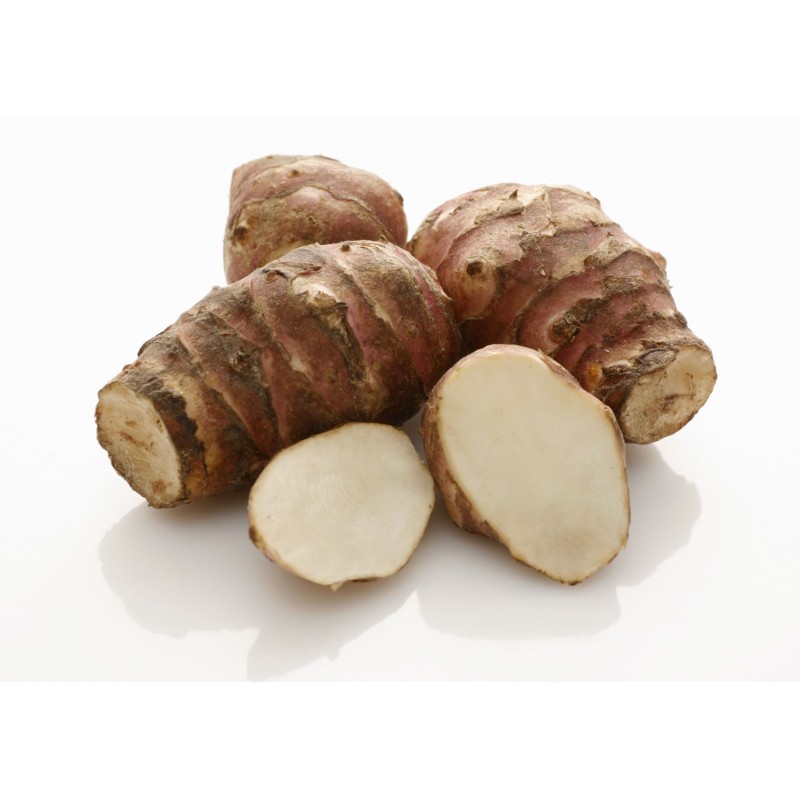The Jerusalem artichoke (Helianthus tuberosus) is related to the sunflower and originally comes from Mexico. From there, it spread across North America to Canada. In 1612, the versatile plant with the potato-sized tubers arrived in Paris and was called the “Indian potato”.
The tubers were given the strange name “Jerusalem artichoke” by an indigenous people from Brazil who called themselves “Tubinambá”. The Tubinambá were suspected of practicing ritual cannibalism. By pure coincidence, they were visiting Paris at the same time to thrill the French aristocracy with wild show dances, just as the new plant was being introduced there. Although they had nothing to do with the Central American tuber, they became the eponym. At first, the sweet-tasting tuber was a popular vegetable throughout Europe because it was nutritious and prevented many a famine. From 1750, however, it was displaced by another tuber that also came from Central and South America: The potato took its place.
Contents
Jerusalem artichoke – nutritious and medicinal
The low-fat Jerusalem artichoke contains far fewer calories than the potato. In terms of minerals, it provides a lot of potassium and iron. Potassium is responsible for the draining effect of the tuber and is important for the functioning of cells, nerves and muscles. Iron enables the red blood cells to transport oxygen. Jerusalem artichoke also contains a lot of vitamin E as well as vitamin B1, which is essential for energy metabolism.
Rich in inulin – popular with diabetics
Jerusalem artichoke tubers have another special feature: they have an exceptionally high content of inulin (16%) and dietary fiber (12.5 g/100 g). The polysaccharide inulin is very popular with diabetics because it does not affect blood sugar levels. It does not require insulin for digestion. In addition, the prebiotic inulin lowers blood lipid levels and positively influences intestinal flora. Dietary fiber is twice as abundant in Jerusalem artichoke as in whole-grain bread. The numerous dietary fibers lower the cholesterol level. In addition, the tuber contains numerous secondary plant substances (polyphenols).
Its a Tuber with artichoke flavor
The taste of the tuber is sweetish-nutty and reminds some people of artichoke bottoms, others of chestnuts. It is probably not for nothing that it also bears the names “earth artichoke” or “Jerusalem artichoke”.
Different ways of preparation
The potato-sized tubers have a thin yellow, red or purple outer skin, depending on the variety. Inside, however, they are all white. You don’t need to remove the thin skin; thorough washing and brushing is all that is required. Only boiling in water makes the skin a bit tough, so you should remove it beforehand. However, boiling is the worst method of preparation anyway, because the taste suffers considerably. Since the peeled and cut Jerusalem artichoke turns brown very quickly, similar to a peeled apple, you should process it quickly. You can grill, fry, steam or bake the tubers.
They are also very good grated as a raw food, possibly mixed with carrots and garnished with roasted sunflower seeds. Or, like potatoes, they can be made into a gratin, soup or puree. However, the inulin-containing tuber favors flatulence, so sensitive people can drink a fennel tea afterwards as a precaution.
The Jerusalem artichoke is easy to cultivate in the garden
The perennial Jerusalem artichoke loves sunny locations and a loose, deep soil. The planting tubers are also offered online by many nurseries and seed companies. You place the tubers about 10 cm deep in the soil from mid-March to the end of April. The row spacing is 60 cm, and the planting distance in the row is about 30 cm. You can mound the rows after emergence similar to potatoes. You can increase the tuber yield if you cut off the flower shoots in late summer (August/September), but this is actually a pity.
Harvesting of newly formed tubers begins in November. If necessary, you can continue them until March. Since the root tubers do not store well, it makes sense to leave them in the ground over winter. They are frost hardy down to -15 °C. There are numerous well-tried varieties that are well suited for cooking, for example the “Gute Gelbe”, the red-colored “Gföhler Rote” or the purple-colored “Violet de Rennes”. Tobinambur has a strong tendency to multiply in the garden – once established it is difficult to remove. Diseases and pests are almost non-existent, only voles are really keen on the juicy tubers.
- Recipe for homemade Jerusalem artichoke chips
- Ingredients
- 600 g Jerusalem artichoke
- 4 tablespoons olive oil
- 1 tsp. sea salt
- Pepper
Depending on preference 1 tsp curry or ½ tsp chili
Preparation
Wash and brush Jerusalem artichokes and cut into 2-3 mm thin slices.
Mix olive oil with salt and spices. Add Jerusalem artichoke and mix well.
Spread the slices on a baking tray lined with baking paper. Bake at 130 °C in a preheated oven for 35-40 minutes, turning once.
Note: The chips should be baked at low temperatures, because then hardly any carcinogenic acrylamide is formed. You can also “roast” them at even lower temperatures: At 60-70 °C, it takes about 8-10 hours. You can use a dehydrator for this purpose.
- Recipe for roasted Jerusalem artichokes with herb curd cheese
- Ingredients
- 750 g Jerusalem artichoke
- 3 tablespoons olive oil or rapeseed oil
- 2 cloves of garlic
- Sea salt
- Pepper
- 250 g low-fat quark
- 50 g cream
- 1 tablespoon horseradish
- salt
- 1 handful of fresh herbs
Preparation
Wash and brush Jerusalem artichokes thoroughly and cut into 0.5-1 cm thin slices.
Cut garlic into thin slices.
Heat olive oil in a pan and fry Jerusalem artichoke for about 10 minutes until golden brown.
After 6 minutes of frying, add the garlic. Season with salt and pepper.
Stir together the remaining ingredients to make a herb curd.










